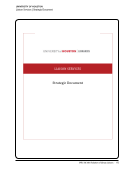SPEC Kit 349: Evolution of Library Liaisons · 181
UNIVERSITY OF KANSAS
KU Libraries’ Consultant Model |Appendix A
11
APPENDIX A
KU Libraries Consultant Model
July 2013
In May 2013, KU Libraries’ executive leadership commissioned the development of a consultant model
sufficiently agile to respond to an ever evolving research and learning landscape. It was determined that
the Libraries’ liaison model, in which an individual librarian performed an array of duties in reference,
collection development, instruction, and department-specific outreach, could not be reliably sustained.
While the liaison model has been a key to the Libraries’ past success, with changing emphases of the
University’s goals and a need to reaffirm the Libraries’ contribution to the University’s mission, a
different model was deemed necessary to meet the complex needs of our patrons. The Libraries’
executive leadership felt it must reposition and re-concentrate the expertise of its faculty and staff in
order to meet emerging user needs and expectations and to address significant Libraries and campus-
level strategic initiatives.
KU Libraries executive leadership appointed three Assistant Deans--Erin Ellis of Research &Learning,
Judith Emde of Content &Access, and Beth Whittaker of Distinctive Collections--to develop a consultant
model for KU Libraries. Over the course of 10 meetings between May 30 and July 10, this group
examined many issues related to the conceptual model of a consultant in a user-centered organization
and the attendant implementation issues, and reflected on feedback received from Libraries employees
through informal conversation and emails, and through consultation with other stakeholders. The
group agreed that the Libraries would be best served by a general “canopy” model that could be applied
to all consultants within the organization, with the understanding that the manifestation and
expectations associated with consultant work will necessarily vary across divisions.
Who are consultants?
Consultants will be the Libraries’ faculty and professional staff members who cultivate and maintain
relationships through proactive, regular engagement with KU faculty and students, as well as our Kansas
community and affiliates, in support of research, teaching and learning.
What will consultants do?
Consultants will be tasked with outreach to their appropriate constituencies to the benefit of KU
Libraries and its strategic initiatives. The specific consultation activities performed by consultants are
dependent upon the division in which the consultant is based the fundamental expectations associated
with consultation in each division will be determined by the respective Assistant Dean and department
heads.
How does the Consultant Model differ from the Liaison model?
As the Libraries transitions into its new organizational structure, many duties formerly performed in the
course of liaison work will be assigned to dedicated personnel, allowing staff to concentrate on their
UNIVERSITY OF KANSAS
KU Libraries’ Consultant Model |Appendix A
11
APPENDIX A
KU Libraries Consultant Model
July 2013
In May 2013, KU Libraries’ executive leadership commissioned the development of a consultant model
sufficiently agile to respond to an ever evolving research and learning landscape. It was determined that
the Libraries’ liaison model, in which an individual librarian performed an array of duties in reference,
collection development, instruction, and department-specific outreach, could not be reliably sustained.
While the liaison model has been a key to the Libraries’ past success, with changing emphases of the
University’s goals and a need to reaffirm the Libraries’ contribution to the University’s mission, a
different model was deemed necessary to meet the complex needs of our patrons. The Libraries’
executive leadership felt it must reposition and re-concentrate the expertise of its faculty and staff in
order to meet emerging user needs and expectations and to address significant Libraries and campus-
level strategic initiatives.
KU Libraries executive leadership appointed three Assistant Deans--Erin Ellis of Research &Learning,
Judith Emde of Content &Access, and Beth Whittaker of Distinctive Collections--to develop a consultant
model for KU Libraries. Over the course of 10 meetings between May 30 and July 10, this group
examined many issues related to the conceptual model of a consultant in a user-centered organization
and the attendant implementation issues, and reflected on feedback received from Libraries employees
through informal conversation and emails, and through consultation with other stakeholders. The
group agreed that the Libraries would be best served by a general “canopy” model that could be applied
to all consultants within the organization, with the understanding that the manifestation and
expectations associated with consultant work will necessarily vary across divisions.
Who are consultants?
Consultants will be the Libraries’ faculty and professional staff members who cultivate and maintain
relationships through proactive, regular engagement with KU faculty and students, as well as our Kansas
community and affiliates, in support of research, teaching and learning.
What will consultants do?
Consultants will be tasked with outreach to their appropriate constituencies to the benefit of KU
Libraries and its strategic initiatives. The specific consultation activities performed by consultants are
dependent upon the division in which the consultant is based the fundamental expectations associated
with consultation in each division will be determined by the respective Assistant Dean and department
heads.
How does the Consultant Model differ from the Liaison model?
As the Libraries transitions into its new organizational structure, many duties formerly performed in the
course of liaison work will be assigned to dedicated personnel, allowing staff to concentrate on their












































































































































































































